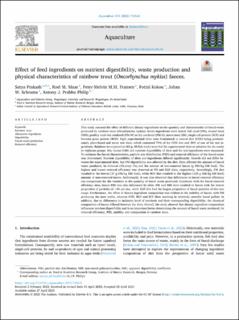| dc.description.abstract | This study assessed the effect of different dietary ingredients on the quantity and characteristics of faecal waste produced by rainbow trout (Oncorhynchus mykiss). Seven ingredients were tested: fish meal (FM), mussel meal (MM), poultry meal wet rendered (PM-W) or dry rendered (PM-D), insect meal (IM), single cell protein (SCP) and brewers grain protein (BGP). Eight experimental diets were formulated: a control diet (CON) being predominantly plant-based and seven test diets, which contained 70% of the CON diet and 30% of one of the test ingredients. Rainbow trout juveniles (65 g, 30 fish/tank) were fed the experimental diets at satiation for six weeks in triplicate groups. Dry matter (DM) and nutrient digestibility of diets and the test ingredients were measured. To estimate the faecal characteristics, particle size distribution (PSD) and removal efficiency of the faecal waste was determined. Nutrient digestibility of diets and ingredients differed significantly. Growth did not differ between the experimental diets, but DM digestibility was affected by the diet. Diets affected the amount of faecal waste produced, its removal efficiency (%) and the amount of non-removed faeces (g DM/kg DM feed). The highest and lowest removal efficiency was observed at FM and BGP diets, respectively. Accordingly, FM diet resulted in the lowest (37 g DM/kg DM feed), while BGP diet resulted in the highest (125 g DM/kg DM feed) amount of non-removed faeces. Additionally, it was also observed that differences in faecal removal efficiency can compensate for the variation in the quantity of faecal waste produced. Consistent with the faecal removal efficiency data, faeces PSD was also influenced by diets. FM and MM diets resulted in faeces with the lowest proportion of particles of <40 μm size, while BGP diet had the largest proportion of faecal particles of this size range. Furthermore, the effect of dietary ingredient composition was evident in the stability of faeces, with FM producing the most stable, whereas CON, BGP and SCP diets resulting in relatively unstable faecal pellets. In addition, due to differences in inclusion level of nutrients and their corresponding digestibility, the chemical composition of faeces differed between the diets. Overall, the study showed that dietary ingredient composition influences nutrient digestibility and is an important factor determining the amount of faecal waste produced, its removal efficiency, PSD, stability and composition in rainbow trout. | |
